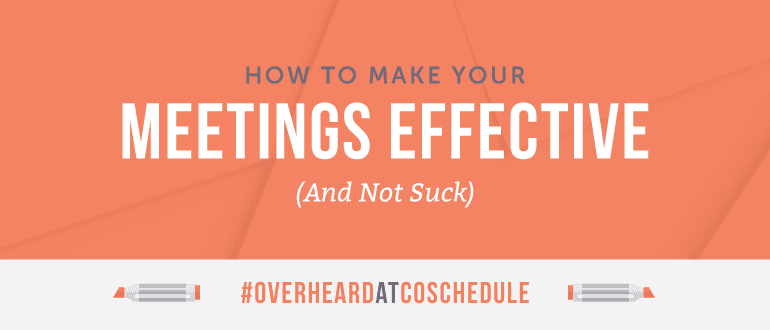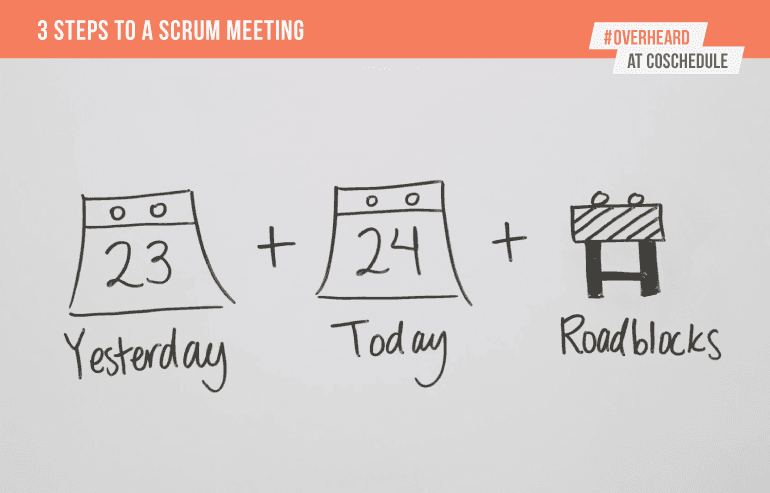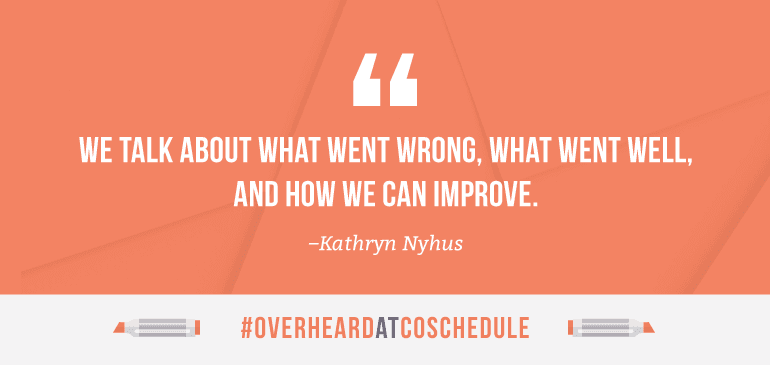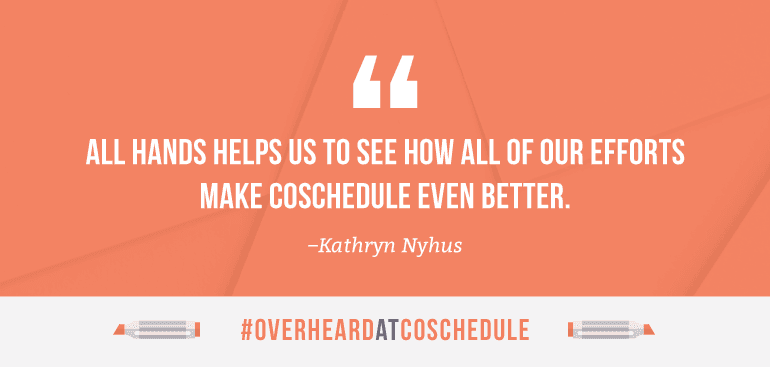How to Make Meetings More Effective (And Not Suck) | #OverheardAtCoSchedule
 Do you dread every meeting invite that hits your inbox? If so, you’re not alone. Meetings are the bane of many a marketer’s existence. They’re seen as a daily disruption rather than a productivity driver. Busy professionals don’t like being slowed down, especially not for commitments that place a drag on productivity.
So, are meetings inherently a waste of time? Not at all. In fact, well-run meetings are critical to the success of any organization. However, meetings at too many companies are poorly planned. They’re often scheduled too frequently, lack clear agendas, and include too many team members. As a result, staff may even tune out completely, twiddling their thumbs until they can leave.
If any of this sounds familiar, you’re not alone.
That’s why we’ve committed to running meetings that don’t suck. By strategically planning our meeting schedule, we’ve been able to improve collaboration, stop problems before they start, and avoid headaches. Everyone leaves feeling focused rather than distracted. We get more done, and the word “meeting” isn’t considered a dirty word anymore.
Sounds like a dream, right? The good news is our meeting structure is easy to replicate. On this episode of #OverheardAtCoschedule, co-founder and CEO Garrett Moon and Product Marketing Lead Kathryn Nyhus explain how you can run effective meetings like we do.
Do you dread every meeting invite that hits your inbox? If so, you’re not alone. Meetings are the bane of many a marketer’s existence. They’re seen as a daily disruption rather than a productivity driver. Busy professionals don’t like being slowed down, especially not for commitments that place a drag on productivity.
So, are meetings inherently a waste of time? Not at all. In fact, well-run meetings are critical to the success of any organization. However, meetings at too many companies are poorly planned. They’re often scheduled too frequently, lack clear agendas, and include too many team members. As a result, staff may even tune out completely, twiddling their thumbs until they can leave.
If any of this sounds familiar, you’re not alone.
That’s why we’ve committed to running meetings that don’t suck. By strategically planning our meeting schedule, we’ve been able to improve collaboration, stop problems before they start, and avoid headaches. Everyone leaves feeling focused rather than distracted. We get more done, and the word “meeting” isn’t considered a dirty word anymore.
Sounds like a dream, right? The good news is our meeting structure is easy to replicate. On this episode of #OverheardAtCoschedule, co-founder and CEO Garrett Moon and Product Marketing Lead Kathryn Nyhus explain how you can run effective meetings like we do.
How to Make Meetings More Effective (And Not Suck)
Click To TweetTranscript
Garrett: All right what's the craziest thing you've ever heard someone say? Kathryn: Let's have more meetings. Garrett: That is crazy. I'm Garrett and this is overheard at CoSchedule and today we are going to talk about why meetings aren't so bad. Meetings have a bad rep and we want to fix that. This is Kathryn. Kathryn leads our product marketing team here at CoSchedule and we are going to talk about the meeting structure that we use so that meetings don't suck, they're always useful, and everyone stays productive and on time. Kathryn why don't you walk us through the first step of that process. Kathryn: Yeah. So every day we have a meeting that we call scrum and this is where we talk about what we did yesterday, what we're doing today, and any blockers that we might have. This helps us just to keep on pace every day and stay focused. A lot of times too, with blockers, people might wait until the last minute to tell you that the reason why they couldn't get that thing done at the end of the week was because of this. This helps us to eliminate those faster. Garrett:
I love it cause it has a really simple one, two, three agenda. Everyone knows what to, same thing every day. Kathryn you manage our product marketing team and I think you guys have some of the more complicated projects like the website project that we just did, we launched last summer. Talk to me about some of the things that you guys did meeting wise to manage a large project like that.
Kathryn:
Yeah, so we had project touchpoints and this was where every day we just had a standing meeting for 30 minutes where we would sync and we would just put up our raw, in progress work, and get feedback, give feedback, and just iterate on the project faster.
Garrett:
Keep it rolling, keep the communication going. Kind of taking that out into our how to do meetings, we have two more meeting that we do at the end of the week. Maybe walk through those two.
Kathryn:
Yeah, so we have retros every Friday. Retros are what we do as an entire department, where we talk about the KPI's that we are constantly tracking for the year. Any weekly wins and then kind of the progress for the following week. We talk about what went wrong, what went well, and how we can improve.
Garrett:
I love it cause it has a really simple one, two, three agenda. Everyone knows what to, same thing every day. Kathryn you manage our product marketing team and I think you guys have some of the more complicated projects like the website project that we just did, we launched last summer. Talk to me about some of the things that you guys did meeting wise to manage a large project like that.
Kathryn:
Yeah, so we had project touchpoints and this was where every day we just had a standing meeting for 30 minutes where we would sync and we would just put up our raw, in progress work, and get feedback, give feedback, and just iterate on the project faster.
Garrett:
Keep it rolling, keep the communication going. Kind of taking that out into our how to do meetings, we have two more meeting that we do at the end of the week. Maybe walk through those two.
Kathryn:
Yeah, so we have retros every Friday. Retros are what we do as an entire department, where we talk about the KPI's that we are constantly tracking for the year. Any weekly wins and then kind of the progress for the following week. We talk about what went wrong, what went well, and how we can improve.
 Garrett:
Yeah, so I think it gives you this consistent, we're always making a little bit better every single week, all the time. The last meeting of the week, the one with the beer.
Kathryn:
Yeah.
Garrett:
That's the one people care about.
Kathryn:
Yeah. This is the one at the end of Friday so you kind of have to have beer with it.
Garrett:
Right.
Kathryn:
It's called all hands. It's where the entire company comes together. I think the biggest piece about this is that a lot of times we're all working in our own departments and we don't really see how each person and each team connects. This helps us to see how all of our efforts make CoSchedule even better.
Garrett:
Yeah, so I think it gives you this consistent, we're always making a little bit better every single week, all the time. The last meeting of the week, the one with the beer.
Kathryn:
Yeah.
Garrett:
That's the one people care about.
Kathryn:
Yeah. This is the one at the end of Friday so you kind of have to have beer with it.
Garrett:
Right.
Kathryn:
It's called all hands. It's where the entire company comes together. I think the biggest piece about this is that a lot of times we're all working in our own departments and we don't really see how each person and each team connects. This helps us to see how all of our efforts make CoSchedule even better.
 Garrett:
What I love about that meeting is we always share weekly wins, we share goals, and everyone gets to see what everyone else is working on.
Kathryn:
Yeah.
Garrett:
It's a simple framework. Write it down, have simple agendas and you can have great meetings and they don't have to suck anymore. That's overheard at CoSchedule. Thanks.
Garrett:
What I love about that meeting is we always share weekly wins, we share goals, and everyone gets to see what everyone else is working on.
Kathryn:
Yeah.
Garrett:
It's a simple framework. Write it down, have simple agendas and you can have great meetings and they don't have to suck anymore. That's overheard at CoSchedule. Thanks.

